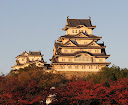
[Update; the list of the other parts: the culture, the food, and the language.]
I started the trip in Hiroshima, where the meeting was, and so I did my first bit of sightseeing there. I had part of a day before the IETF meeting started, and, as I noted in August, I was particularly interested in considering the end-of-World-War-II bombing and seeing how the city had been rebuilt, I started by walking around the area, and then went to Peace Memorial Park, set up to remember the victims and to promote world peace.
Hiroshima is situated along the Seto Inland Sea, at the spot where the Ota River empties into the sea. The Ota splits, there, into a number of smaller rivers. The Motoyasu is the branch near where I stayed.
The city itself is, as I said in August, a modern city, and one that looks largely like any other such, with office buildings, hotels, restaurants, and shopping areas. There’s a Starbucks in the NHK building across the street from the meeting hotel (the ANA Crown Plaza). There are several major shopping areas nearby, and, as here, they’re frequented by young people spending money on fashion. A town like any other.
Until you see the “Atomic Bomb Dome”. Originally the Hiroshima Prefectural Commercial Exhibition Hall, it sits near the bridge over the Motoyasu that was the target point for the bomb, which detonated a few hundred feet away, and 2000 feet in the air. It’s remarkable that a significant portion of this building remained standing, considering that it was so close to the center of the blast. It has been left as it was, as a memorial, and is registered as a UNESCO World Heritage Site, the first of three I visited on this trip.

I did a lot of thinking while I was in the park. I was also snagged by a charming group of uniformed school-kids, who asked me about my trip as part of an assignment for their English class. That took a lot of the heaviness away, and helped focus on the “peace” aspect.
The Friday after the meeting saw a bunch of us take the ferry to Itsukushima, colloquially known as Miyajima, Shrine Island. The island, in the Seto Inland Sea, is quite a tourist spot, known for the Itsukushima Shrine, a major Shinto shrine that was the second UNESCO World Heritage Site on my trip, and for Mount Misen, towering over the island. The torii (gate) to the shrine is one of the most photographed sights in the area, and the view from the top of Mount Misen is wonderful — it’s a pity the weather wasn’t clear that day.

There was also a Shinto wedding going on while we were visiting the Itsukushima Shrine. A very different affair from western weddings, it involved little or no talking, at least during the portion we saw. In the photo, the bride is on the right in the back, the groom is on the left, and the woman between them is taking things, such as a goblet to drink from, to each of them in turn. The only sound is dissonant music, unusual to western ears.

Near the castle is the Koko-en Garden — a very pleasant place, and you can buy a discounted combination ticket to see both the castle and the garden. The garden also offers a formal tea ceremony, which we did not have a chance to see.
On Sunday, we took the Shinkansen to Tokyo, and got on the Yurikamome — part of the Tokyo metro transit system, and entirely run by computers — over the Rainbow Bridge to Odaiba, an artificial island that was built in the bay. We spent the afternoon there at the Miraikan — the National Museum of Emerging Science and Innovation. The Miraikan is an excellent museum, with lots of hands-on stuff and cool demonstrations. They had to chase us out when they closed.
I had Monday and part of Tuesday in Tokyo on my own, and I spent Monday walking around, checking out the Imperial Palace (which one can’t go into) and the East Gardens and the Kitanomaru Garden (which one can). 
On Tuesday I tried the subway system, and found it very easy to use. The odd thing is that while all the ticket machines are touch-screen systems, they do not all run the same software, and only some of them have an option to use English. So one has to check out each machine, looking for one that has a touch-screen “button” that says “English”. Anyway, I rode the Ginza line from the Kyobashi station to Ueno, and went to the Tokyo National Museum, a place that showcases the art and culture of Japan.
And that ended the trip: back to the Tokyo train station, on the Narita Express to the airport, and into the plane to ニューアーク (nyuu-aa-ku, Newark). I’ll soon have other parts of the Japan series, talking about the culture, the food, and the language.






No comments:
Post a Comment